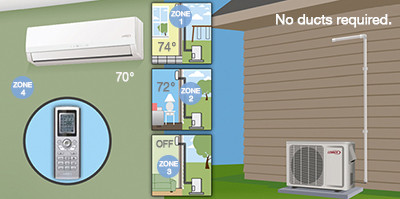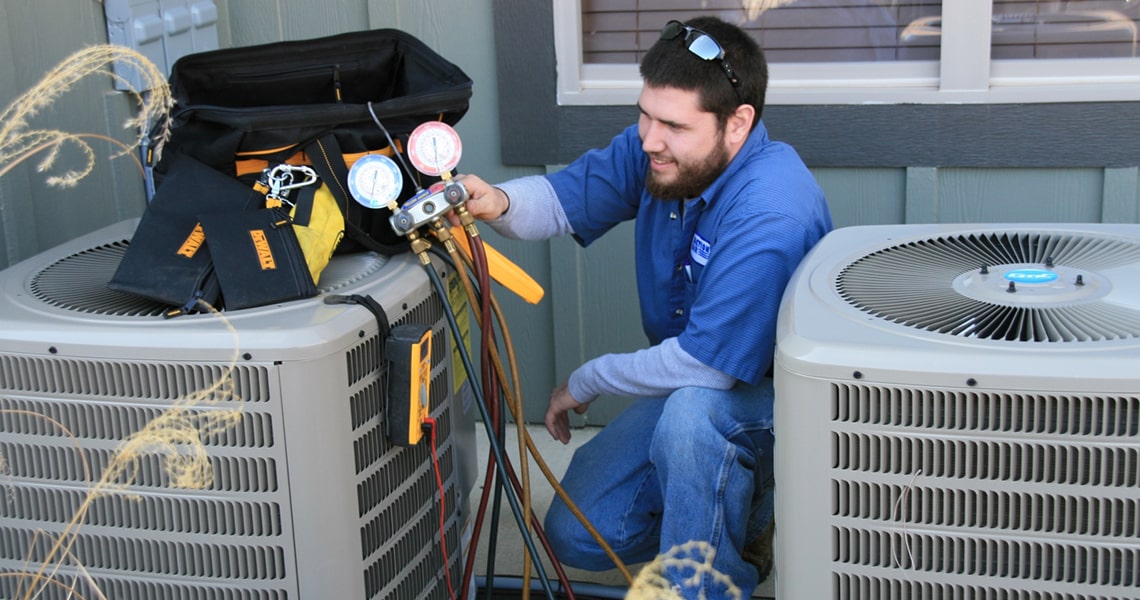When it involves making architectural areas, the old saying 'form complies with feature' is true. Yet have you ever took into consideration just how integrating cooling into architecture can raise convenience and performance at the same time?
The seamless blend of cooling systems within the structure of a building not only impacts the owners' wellness but additionally influences the total sustainability of the framework. As you check out the complex relationship in between design and cooling, a world of cutting-edge options and sophisticated modern technologies awaits your discovery.
Key Takeaways
- Energy-efficient systems improve comfort and sustainability.
- Integrated air conditioning enhances indoor air top quality.

- Balancing aesthetics and functionality ensures excellent layout.
- Future trends concentrate on wise, lasting air conditioning options.
Significance of Integrated Cooling
When designing areas, incorporating a/c is important for ensuring the most effective comfort and performance. Energy effectiveness plays a vital duty in the style process, as it not just reduces functional prices but also lessens the ecological impact of the structure. By integrating energy-efficient a/c systems, you can produce a sustainable and economical solution that profits both the residents and the planet.
In addition, interior air top quality is another crucial aspect to take into consideration when creating with incorporated a/c. Correct air flow and filtration systems help preserve a healthy and balanced interior environment by minimizing contaminants and allergens. This leads to enhanced occupant health and wellness and performance. When selecting air conditioning systems, focus on those that supply advanced purification technologies to boost the total indoor air quality.
Variables Influencing Style Choices
Incorporating cooling into building layouts requires careful consideration of numerous factors that influence style decisions. When incorporating a/c systems, sustainability factors to consider are important to minimize the building's ecological effect. User experience plays a considerable role in figuring out the performance and complete satisfaction with the cooling system.
- Energy Effectiveness: Sustainable style methods intend to decrease power intake, which not just benefits the setting however also lowers functional prices for the structure owner.
- Indoor Air Top Quality: Offering a comfortable and healthy interior environment boosts the general user experience, promoting performance and well-being.
- Aesthetics and Combination: Integrating a/c systems effortlessly right into the building design guarantees that performance does not jeopardize the visual allure of the area, boosting individual contentment and general structure looks.
Effective Cooling Down Strategies for Buildings
To enhance cooling down efficiency in structures, think about integrating passive design methods alongside a/c systems. Easy air conditioning methods can considerably lower the requirement for mechanical cooling, bring about even more sustainable options for keeping comfy interior temperatures. Design features such as shielding gadgets, all-natural air flow systems, and thermal mass can assist regulate temperatures without counting only on energy-intensive air conditioning. By purposefully placing home windows to optimize cross air flow or making use of reflective roof covering materials to reduce solar warmth gain, you can harness the power of nature to cool your building efficiently.
Along with easy strategies, carrying out sustainable options like environment-friendly roof coverings or living wall surfaces can even more boost cooling efficiency by giving insulation and decreasing warm absorption. These functions not just assist in maintaining comfortable indoor temperatures yet additionally contribute to a greener atmosphere. By integrating passive cooling strategies with lasting services, you can develop a more energy-efficient and eco-friendly structure design that focuses on both convenience and conservation.
Stabilizing Aesthetic Appeals and Functionality
Take into consideration the unified integration of visual aspects with useful elements in your building design to guarantee a balanced and impactful end result. When including air conditioning systems into your structure design, striking an equilibrium between visual appeals and performance is key to creating rooms that not only look excellent but also supply ideal convenience for residents.

To attain this balance, keep the complying with points in mind:
- Mix the System with the Environments: Make certain that the a/c systems or vents flawlessly integrate with the overall visual of the room, whether with hidden positioning, attractive covers, or matching shades.
- Focus On User Experience: Design the air flow and temperature control systems in a manner that focuses on the convenience and well-being of the residents. Think about variables such as air distribution, noise levels, and simplicity of use to boost the general customer experience.
- Integrate Lasting Practices: Choose energy-efficient cooling options that not just add to the visual charm of the structure yet likewise promote sustainability and reduce environmental impact.


Future Fads in Architectural Air Conditioning
As you envision the future of architectural layout, staying abreast of emerging air conditioning patterns comes to be essential for improving both form and function within your projects.
The assimilation of clever technologies right into architectural air conditioning systems is set to reinvent the means buildings are cooled. These systems make use of data and automation to maximize power usage, providing personalized comfort while reducing ecological influence.
Lasting services are likewise forming the future of building air conditioning. From easy style approaches that take full advantage of all-natural air flow to innovative air conditioning materials that lessen the demand for traditional air conditioning, sustainability is at the center of cooling innovations. Engineers are increasingly incorporating green roofing systems, shielding aspects, and thermal mass right into their designs to create even more energy-efficient cooling systems.
Regularly Asked Concerns
How Does Cooling Effect the Total Sustainability and Power Performance of a Structure Design?
When you integrate cooling right into building style, it impacts sustainability and power efficiency. Power consumption can rise because of air conditioning use, affecting building efficiency. This enhanced energy demand can have unfavorable ecological impacts, decreasing total sustainability.
To alleviate these effects, think about integrating energy-efficient cooling and heating systems, appropriate insulation, and passive cooling strategies. Balancing convenience with power effectiveness is very important for developing sustainable architectural designs.
Are There Any Kind Of Laws or Certifications That Architects Required to Consider When Integrating Air Conditioning Into Their Designs?
When incorporating cooling into your layouts, it's vital to take into account regulative requirements like building ordinance and certification requirements for power efficiency. Fulfilling these standards guarantees that your task lines up with industry ideal techniques and environmental objectives.
Familiarizing yourself with these policies will aid you in developing lasting designs that prioritize convenience while additionally minimizing power consumption. Stay informed and certified to supply projects that are both comfy and environmentally friendly.
Can the Placement of A/c Units Influence the Overall Comfort and Functionality of an Area?
When it pertains to cooling systems, placement matters a whole lot for your area's comfort and capability. Air blood circulation is essential, so avoid obstructing vents or positioning devices in tight corners.
Consider how environmental pollution can influence your environment and go for a visually pleasing setup that mixes effortlessly with your spatial layout.
Take note of where you position these devices to guarantee maximum comfort and efficiency throughout your space.
What Are Some Ingenious Technologies or Products That Can Be Made Use Of to Improve A/c Systems in Modern Architecture?
To improve air conditioning systems in modern architecture, you can discover clever controls and lasting products. Easy air conditioning techniques and using thermal mass are innovative means to boost efficiency and convenience.
How Can Architects Ensure That the Layout of Cooling Systems Matches the Overall Visual of a Structure While Still Focusing On Performance and Comfort?
To guarantee the design of a/c systems enhances a structure's aesthetic, prioritize aesthetic assimilation and style harmony. Integrate energy-efficient technologies for capability. Balancing looks and capability improves passenger convenience.
Emphasize seamless assimilation of cooling aspects right into the architectural design. https://crystalpalaceacinstallation.co.uk By concentrating on both aesthetic appeals and power performance, architects can create an area that's aesthetically enticing, comfortable, and eco-friendly.
Verdict
On the whole, when developing with comfort in mind, integrating cooling in architecture is important. By considering factors such as effective air conditioning strategies, balancing appearances and performance, and staying ahead of future patterns, architects can produce spaces that aren't just aesthetically appealing however additionally comfy for residents.
It's important to prioritize the well-being and comfort of those that'll be using the room, and incorporated a/c plays a key function in attaining this goal.
